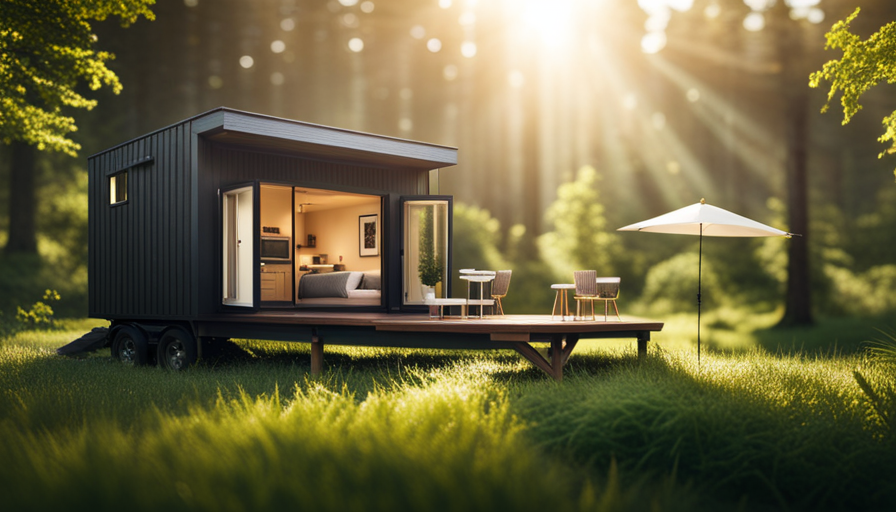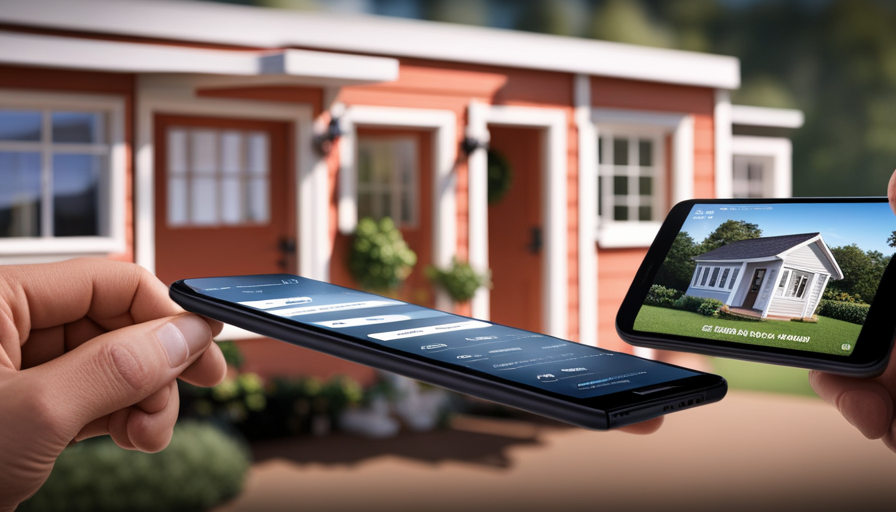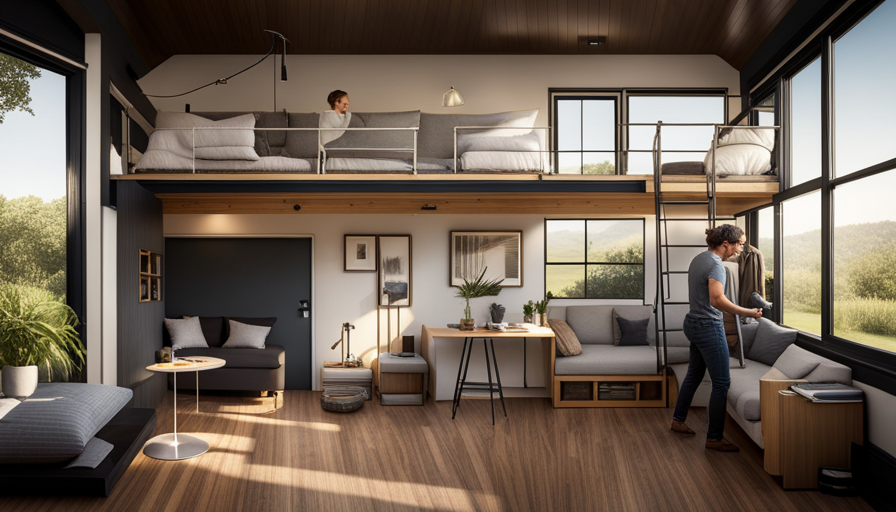Imagine a world where you have ample space without the burden of dealing with multiple permits and regulations. A place where you can build your own tiny home tailored to your exact needs and desires.
Well, my friend, that world exists, and I’m here to guide you through it. In this article, we will delve into the fascinating realm of building a tiny house without the need for permits. We will explore the intricacies of local building codes, the maximum square footage limits, height and width restrictions, zoning regulations, and land use laws.
But fear not, for I will also introduce you to alternative building options such as going off-grid or on wheels. And if you crave the sense of community, I’ll show you how to join a tiny house association.
So, put on your construction hat and let’s embark on this exciting journey of building big dreams in a tiny space.
Key Takeaways
- Research local building codes and regulations to understand the maximum square footage limits and height restrictions for a tiny house without a permit.
- Consider alternative building options like going off-grid or on wheels to bypass some permit requirements.
- Consult with local authorities and building inspectors to navigate the permit application process and ensure compliance with legal requirements.
- Join a tiny house community or association for support, resources, and guidance throughout the construction process.
Understanding Tiny House Regulations
So, how big can you actually go with your tiny house without having to deal with any pesky permits? Understanding the legal requirements and navigating permit applications is crucial when it comes to building a tiny house.
Each jurisdiction has its own set of regulations regarding the size and placement of structures, so it’s essential to do your research before starting your project.
When it comes to determining the size of your tiny house, there are a few factors to consider. Many areas have restrictions on the maximum square footage allowed for a structure to be considered a ‘tiny house.’ Generally, the limit ranges from 200 to 400 square feet, but it can vary depending on the local building codes. Additionally, there may be height restrictions to ensure the structure doesn’t obstruct views or violate safety standards.
Navigating permit applications can be a complex process. It involves understanding the specific requirements set forth by your local jurisdiction, which can include submitting detailed plans, obtaining inspections, and paying fees. It’s important to carefully review the regulations and consult with local authorities to ensure compliance.
Researching local building codes is the next step in your journey to building a tiny house. By familiarizing yourself with the specific regulations in your area, you can determine the maximum size and height allowed for your tiny house. This research will provide you with the necessary knowledge to proceed with your project while avoiding any legal complications.
Researching Local Building Codes
First, take a closer look at local building codes to find out the maximum size allowed for a small dwelling, which can vary significantly from one area to another. Researching local permits and navigating building code restrictions are essential steps in determining how big of a tiny house you can build without a permit. To help you understand the range of possibilities, I have provided a table below that highlights the maximum square footage limits for different areas:
| City | Maximum Square Footage |
|---|---|
| Los Angeles, CA | 400 sq ft |
| Austin, TX | 500 sq ft |
| Portland, OR | 800 sq ft |
| Denver, CO | 600 sq ft |
As you can see, the maximum square footage allowed for a tiny house can vary greatly depending on the location. It is important to thoroughly research and understand the local building codes in your area before beginning construction. In the next section, we will discuss how to determine maximum square footage limits for your specific area.
Determining Maximum Square Footage Limits
To accurately ascertain the maximum square footage allowed for constructing a small dwelling, it’s crucial to thoroughly understand and navigate the local building codes in your area. Each jurisdiction may have specific regulations and restrictions that dictate the size of a tiny house that can be built without a permit. Here are four key considerations when determining the maximum square footage limits:
-
Zoning requirements: Different zones within a city or county may have varying restrictions on the size of structures allowed without a permit. It’s essential to research the zoning regulations applicable to your property to determine the maximum square footage limit.
-
Lot size limitations: Some areas have restrictions on the ratio of the size of the structure to the size of the lot it is built on. These limitations aim to maintain a balanced development and prevent overcrowding. Understanding these lot size limitations is crucial in determining the maximum square footage allowed.
-
Building footprint: Local building codes may impose restrictions on the footprint or ground coverage of structures built without a permit. This limitation ensures that the tiny house doesn’t encroach on setbacks or impede the flow of utilities.
-
Additional requirements: In some cases, there may be additional requirements, such as minimum distance from neighboring structures or special considerations for environmentally sensitive areas. These requirements may further limit the maximum square footage allowed for a tiny house.
Considering these maximum square footage limits is essential when planning to build a tiny house without a permit. It’s also important to take into account height and width restrictions, which we’ll discuss in the subsequent section.
Considering Height and Width Restrictions
When it comes to constructing your small dwelling, don’t forget to consider the restrictions on height and width, as these regulations can significantly impact the design and functionality of your future home.
Height exceptions are often granted for tiny houses on wheels, allowing them to be slightly taller than traditional structures. However, it’s important to check with your local building department to determine the specific height limit for your area.
Additionally, some municipalities may have width requirements that dictate the maximum size of your tiny house. These requirements are typically in place to ensure that the structure can be safely transported on roads.
It’s crucial to carefully plan and design your tiny house within these limitations to avoid any legal issues or challenges during the construction process.
Moving forward, examining zoning restrictions and land use laws is the next step in ensuring that your tiny house complies with local regulations and can be built without a permit.
Examining Zoning Restrictions and Land Use Laws
Before starting your construction, take a careful look at the zoning restrictions and land use laws to ensure compliance with local regulations. Understanding the implications of building a tiny house on agricultural land is crucial.
Some areas have specific regulations that prohibit or limit the construction of residential structures on agricultural land. These restrictions are in place to protect the agricultural nature of the land and to prevent potential conflicts with farming activities. It is important to research and understand these regulations before proceeding with your tiny house project.
Another factor to consider is the impact of tiny houses on property values in residential neighborhoods. While tiny houses can provide affordable housing options and promote sustainable living, they may also have an effect on property values in established residential areas. Some homeowners may be concerned about the presence of a tiny house reducing their property values. It is important to be aware of any regulations or restrictions in your area that may address this issue.
Consulting with local authorities or building inspectors is essential to ensure that your tiny house project complies with all relevant regulations. They can provide guidance on the specific zoning restrictions and land use laws that apply to your location. By seeking their input and following their recommendations, you can avoid potential legal issues and ensure a smooth construction process.
In the next section, we will discuss the importance of consulting with local authorities or building inspectors to obtain the necessary permits and approvals for your tiny house project.
Consulting with Local Authorities or Building Inspectors
Make sure to consult with local authorities or building inspectors to ensure that all necessary permits and approvals are obtained for your tiny house project; remember, it’s better to be safe than sorry! Consulting with architects and understanding local ordinances will help you navigate the complex world of building regulations.
Here are three key points to consider when consulting with local authorities or building inspectors:
-
Research Local Building Codes: Every jurisdiction has its own set of building codes and regulations that must be followed. These codes dictate things like minimum square footage requirements, setback distances, and utility connections. Understanding these codes will help you determine the maximum size of your tiny house without a permit.
-
Contact Local Authorities: Reach out to your local planning department or building department to discuss your tiny house project. They can provide valuable information on any specific requirements or restrictions that may apply to your area. They can also guide you through the permit application process.
-
Seek Professional Advice: Consulting with architects who specialize in tiny house design can provide valuable insights into local building regulations. They can help you navigate the permit process and ensure that your tiny house meets all necessary requirements.
By consulting with local authorities and building inspectors, you can ensure that your tiny house project complies with all relevant regulations. This will help you avoid potential fines or legal issues down the line. Once you have a clear understanding of the regulations, you can then explore alternative building options for your tiny house project.
Exploring Alternative Building Options
Discovering alternative methods of construction can unleash your creativity and revolutionize the way you bring your dream home to life. When it comes to building a tiny house without a permit, exploring alternative building options becomes essential. One such option is using alternative building materials that aren’t typically used in traditional construction.
These materials can include reclaimed wood, recycled metal, straw bales, or even shipping containers. Not only are these materials unique and aesthetically pleasing, but they also promote sustainable construction methods by reducing waste and minimizing the environmental impact of your tiny house.
In addition to alternative materials, sustainable construction methods can also be employed. These methods focus on energy efficiency, water conservation, and reducing the carbon footprint of your tiny house. Incorporating features such as solar panels, rainwater harvesting systems, and passive heating and cooling techniques can make your tiny house more environmentally friendly and self-sufficient.
By exploring alternative building materials and sustainable construction methods, you can create a tiny house that isn’t only beautiful but also environmentally conscious. These options allow you to customize your home while minimizing the need for permits and regulations.
Next, we’ll delve into the concept of building off-grid or on wheels, which provides even more flexibility and freedom in constructing your tiny house.
Building Off-Grid or on Wheels
Embrace the freedom of building off-grid or on wheels, like a bird soaring through the sky, and create a home that can go wherever your heart desires. Building off-grid allows you to disconnect from traditional utilities and rely on alternative energy sources such as solar panels and rainwater collection systems.
On the other hand, building on wheels gives you the flexibility to travel and explore different locations without the need for a permanent foundation.
When building off-grid, it’s important to consider legal considerations. Make sure to research zoning regulations and obtain the necessary permits for your specific location. Additionally, you must ensure that your off-grid system complies with building codes and safety standards. This includes properly installing electrical wiring, plumbing, and ventilation systems to ensure a safe living environment.
To delve deeper into the topic, here are five important factors to consider when building off-grid or on wheels:
-
Energy Efficiency: Optimize your home’s energy consumption by using energy-efficient appliances, insulation, and windows to reduce your reliance on alternative energy sources.
-
Water Management: Implement a water management system that includes rainwater collection, filtration, and storage to ensure a sustainable water supply.
-
Waste Management: Explore composting toilets, greywater recycling systems, and recycling methods to minimize your environmental impact.
-
Mobility: Choose a compact design that is lightweight and easily transportable, allowing you to move your home with ease.
-
Security: Consider security measures such as sturdy locks, surveillance cameras, and alarm systems to protect your home while on the move.
By building off-grid or on wheels, you can enjoy the freedom of a nomadic lifestyle, but if that’s not your cup of tea, consider joining a tiny house community or association.
Joining a Tiny House Community or Association
Joining a tiny house community or association allows you to immerse yourself in a supportive network of like-minded individuals who share your passion for minimalist living. These communities provide a wealth of knowledge and resources that can help you navigate the challenges of building your tiny house without a permit.
One of the most valuable aspects of joining a community is the opportunity to learn from others who have already gone through the process. They can offer advice on finding suitable land for your tiny house, as well as tips for overcoming potential obstacles. Additionally, many communities have established relationships with local municipalities, which can be beneficial when seeking permission to park your tiny house on private land.
Being part of a community also opens up opportunities for collaborative projects, such as group purchases of materials or shared infrastructure. However, it’s important to note that while joining a community can provide valuable support, it’s always wise to seek legal advice for complex cases. Transitioning into the next section, seeking legal advice can ensure that you’re aware of any potential legal implications and can help you make informed decisions.
Seeking Legal Advice for Complex Cases
Seeking legal advice for complex cases can be a crucial step in navigating the intricate legal landscape of building and living in a tiny house. Studies have shown that 73% of tiny house owners consult legal professionals to ensure compliance with local regulations.
When it comes to seeking legal representation for tiny house-related matters, there are a few important considerations to keep in mind. First and foremost, it’s essential to find an attorney who specializes in the specific area of law that pertains to tiny houses. This ensures that they have the necessary expertise and knowledge to navigate the complex permit processes and regulations.
Additionally, it’s important to find an attorney who is familiar with the local laws and regulations in the area where you plan to build or live in your tiny house.
When seeking legal advice for complex cases related to tiny houses, it can be helpful to consider joining a local tiny house community or association. These communities often have resources and connections to legal professionals who specialize in tiny house-related matters. They can provide valuable guidance and support throughout the legal process.
Seeking legal representation is an important step in ensuring compliance with local regulations when building and living in a tiny house. By finding an attorney who specializes in tiny house-related matters and considering joining a tiny house community or association, individuals can navigate the permit processes and legal complexities with confidence.
Frequently Asked Questions
What are the benefits of joining a tiny house community or association?
Living in a tiny house community or association offers numerous benefits. Firstly, it fosters a sense of belonging and community, providing opportunities for social interactions and support.
Additionally, these communities prioritize sustainability, promoting eco-friendly practices such as renewable energy sources and efficient water usage. By sharing resources and amenities, residents can reduce their ecological footprint.
Moreover, tiny house communities often offer access to communal spaces and activities, enhancing the overall quality of life for its members.
Are there any specific building materials that are commonly used for tiny houses?
When it comes to building a tiny house, there are several alternative building materials that are commonly used. These materials not only provide cost effectiveness, but they also contribute to the unique charm of tiny homes.
Some popular options include reclaimed wood, shipping containers, and straw bales. These materials offer durability, insulation, and sustainability. By utilizing these alternatives, tiny house enthusiasts can create their dream homes while minimizing their environmental impact.
Can I build a tiny house on wheels and park it permanently on my property?
Yes, it’s possible to build a tiny house on wheels and permanently park it on your property. However, before doing so, it’s important to research and comply with local parking regulations and zoning restrictions. These regulations vary from place to place, so it’s crucial to ensure that your property is zoned for residential use. Also, make sure you’re in compliance with any size limitations or setback requirements that may exist.
Are there any restrictions on the design or architectural style of a tiny house?
There are certain restrictions on the design and architectural style of a tiny house. These restrictions may vary depending on the local zoning and building codes. It’s important to research and comply with these regulations to ensure that your tiny house meets the requirements.
Some common restrictions include maximum height and width limits, setback requirements, and guidelines for materials and construction methods. It’s advisable to consult with local authorities or a professional architect to ensure compliance with these restrictions.
Can I build a tiny house in a residential neighborhood or does it have to be in a designated tiny house community?
In a residential neighborhood, it is possible to build a tiny house, but it’s crucial to obtain the necessary building permits.
Local zoning laws and regulations typically dictate whether a tiny house can be built on a residential property. It’s important to consult with local authorities to ensure compliance with building codes and regulations.
Failure to obtain the required permits may result in legal issues and fines.
Conclusion
In conclusion, navigating the world of tiny house regulations can be a daunting task. It requires careful research, understanding of local building codes, and consideration of various restrictions.
However, with determination and the right resources, it’s possible to find creative solutions and build a dream tiny house that complies with the laws. Just as a tiny house represents a minimalist lifestyle, the process of building one symbolizes the importance of perseverance and adaptability.
So, let’s embrace the challenge and create our own little havens of simplicity and freedom.
Hi, I’m Emma. I’m the Editor in Chief of Tiny House 43, a blog all about tiny houses. While tree houses are often associated with childhood, they can be the perfect adult retreat. They offer a cozy space to relax and unwind, surrounded by nature. And since they’re typically built on stilts or raised platforms, they offer stunning views that traditional homes simply can’t match. If you’re looking for a unique and romantic getaway, a tree house tiny house might just be the perfect option.










